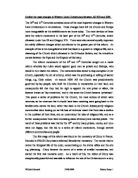Why were the Normans able to extend their control over southern Italy and Sicily so successfully between 1050 and 1100?
Why were the Normans able to extend their control over southern Italy and Sicily so successfully between 1050 and 1100?
In the fifty years following 1050, the Normans made great advances in both southern Italy and Sicily. These successes cannot be solely put down to one factor but instead an accumulation. The Normans were well known for their ferocity in battle being direct descendants of Vikings. Their prowess in battle was only elevated by the fact that the peoples of southern Italy were deeply divided contrasting the unity of the Normans. Some may also put the Normans success down to fortuitous chance.
Firstly, the Normans success can be put down to their military superiority. Despite the fact that Cavalry were extremely difficult to reorganise after a charge and it is possible that the numbers and the effects of horsemen have been exaggerated, the impact has not and in battle it was truly impressive, the Normans ability to coordinate land and Sea attacks further supplemented their success. The calibre of the Norman troops was also not to be scoffed at, and their services at this time were in high demand, proving their reputation of strength in battle. Yet this was not always positive as this could lead to Normans pitched both sides of the Battlefield, as was the case during the crucial siege of Bari in 1071. However it is likely that these men were of low importance as such not to heavily swing the favour of the battle against the Normans. If lowly Norman warriors were rated at such a high value, one can only imagine the effects of the heavy armoured cavalry. The charge of the Normans horses had become both feared and famous. It was held to be almost irresistible so much so that Anna Comnena wrote that it “might make a whole in the walls of Babylon”. The widely used equine Norman tactic was used at the battle of Civitate to full effect, where attacks were made repeatedly and vigorously eventually overwhelming the tight formations of the Popes Swabian mercenaries, one of the Norman’s many great successes due to such equine tactics of which the Normans used and evolved to suit them. The ability to coordinate land and sea attacks was also mastered and used to great effect, eventually also incorporating the ability for their ships to carry Horses. It was the co-ordinated blockade by sea and land which brought about the capture of Bari in 1071. The transportation of Horses can be first seen in 1060-1061, near Messina, which was quickly captured after just one reconnaissance raid. On the other hand it is very hard to judge the effect of the Norman’s ships and fleets with limited sources. Numbers have probably also been exaggerated over the centuries. As such it is extremely doubtful that 3000 mounted men sustained the Norman cause at Civitate. It is doubtful whether Roger could even put more than 1000 mounted men with varied equipment on the battle field at one time. However this surely once again shows the Norman superiority, as they still emerged victorious thanks to their use of tactics despite not having great masses of men to spare.








